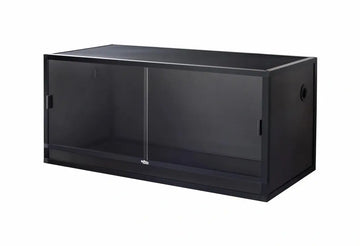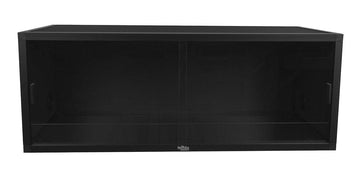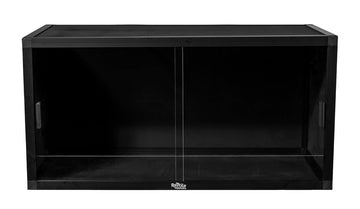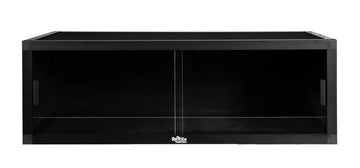The black breasted leaf turtle (Geoemyda spengleri) is a 3-4.5” long species of terrestrial turtle native to southeastern China and northern Vietnam. They can most often be found in montane forests with plenty of leaf litter and woody debris, and proximity to bodies of shallow freshwater.
Black breasted leaf turtles generally have a brown shell with darker skin, and accents of dark orange or red. What makes them most distinctive, however, is their pale tan to silver irises. This species of turtle lacks webbed toes, and their shell features three keeled ridges, with serrated edges.
Black breasted leaf turtles can make excellent pets due to their manageable size and inquisitive nature.
Minimum terrarium size for black breasted leaf turtles
The minimum acceptable enclosure size for a black breasted leaf turtle is 36”L x 18”W x 16”H. This means that they can easily be housed in a terrarium, which also helps with managing their humidity needs.
Cohabitation (housing multiple black breasted leaf turtles in one enclosure) is not recommended.
Do black breasted leaf turtles need UVB?
Yes, black breasted leaf turtles require regular exposure to UVB light to maintain good health. The best UVB bulbs for this species are:
- Arcadia T5 HO 6%
- Zoo Med T5 HO Reptisun 5.0
Your UVB bulb should be half the length of the enclosure, mounted in a reflective Arcadia or Vivarium Electronics fixture, and placed 7-9” above the top of the turtle’s shell when basking. The fixture should be placed over the enclosure’s mesh top.
Lamps should be on for 12 hours/day, or programmed to sync with your local sunrise and sunset times. This is likely to boost your turtle’s long-term health by encouraging natural hormonal rhythms.
Best temperature for black breasted leaf turtles
Like other reptiles, black breasted leaf turtles are cold-blooded, which means that they rely on external temperatures to manage their own body temperature and metabolism. A reptile’s enclosure should offer a range of temperatures to allow them to thermoregulate effectively.
Specifically speaking, black breasted leaf turtles should have a basking temperature between 85-90°F. On the other side of the enclosure, the temperature should be between 68-80°F. These temperatures should be measured with at least two digital probe thermometers. Heating should be turned off at night, and temperatures allowed to drop as low as 60°F.
Provide heat for your turtle with a 40-60w incandescent heat bulb mounted in a ceramic lamp fixture. Do not use ceramic heat emitters (CHEs), red bulbs, or blue bulbs, as these are not as effective.
Best humidity levels for black breasted leaf turtles
Black breasted leaf turtles need an average humidity of 60-80%. There should also be a humid hide on the cool side, lined with moistened sphagnum moss. Humidity should be measured via digital probe hygrometer, with the probe placed in the middle of the enclosure.
Increase humidity by misting the enclosure 2x/day with a pressure sprayer. Mist first thing in the morning and then again at night. Mixing water directly into the substrate also helps with maintaining high humidity if you live in a particularly dry climate.
Although black breasted leaf turtles are terrestrial rather than semi-aquatic, they still enjoy a good soak! Provide a shallow tray of water in the enclosure for your turtle to wade through and drink from. This will also function as a water dish, so make sure to keep the water clean at all times.
Best substrate for black breasted leaf turtles
Providing a thick layer of naturalistic substrate (“bedding”) will help maintain correct humidity levels and also provide something for your turtle to dig in as desired. We recommend the following substrates for black breasted leaf turtles:
We also recommend providing a thick layer of leaf litter and sphagnum moss for enhanced humidity and enrichment value.
Substrate should be at least 3” deep and completely replaced every 3-4 months. Remove poop and urates daily, along with contaminated substrate.
How to decorate a black breasted leaf turtle terrarium
An empty terrarium makes for a bored turtle, reducing its quality of life. Keep your pet entertained and engaged with its environment with the strategic use of décor items that encourage it to exercise natural behaviors!
Here are some ideas to get you started:
- additional hiding places/burrows
- driftwood
- hollow logs
- cork flats
- live or artificial plants
The more stuff you add, the more functional your enclosure is likely to become!
What to feed to a black breasted leaf turtle
Black breasted leaf turtles are primarily carnivorous, which means that they need a diet of mostly animal-based foods in order to get the right nutrition. For best health, juveniles should be fed exclusively on animal prey every day. Adults can be fed on the same schedule, but with small amounts of fruit offered as well.
Protein sources for black breasted leaf turtles: dubias, discoids, earthworms, mealworms, snails, crickets, hornworms, silkworms, black soldier fly larvae, darkling beetles, pinky mice
Fruits for black breasted leaf turtles: cherries, strawberries, raspberries, plums, watermelon, tomatoes, bananas
Supplements
You will also need calcium and vitamin supplements to prevent your turtle from developing a potential deficiency. We recommend Repashy Calcium Plus LoD, lightly dusted on all prey.
How to handle your black breasted leaf turtle
Black breasted leaf turtles, like most turtles, are not the kind of pet that can be handled regularly. It’s best to keep a hands-off approach with this species. If you want to interact with your pet, hand-feed them at mealtime with a pair of soft-tipped feeding tongs.
*This care sheet contains only very basic information. Although it’s a good introduction, please further your research with high-quality sources. The more you know, the better you will be able to care for your pet!
"Black-breasted leaf turtle (Geoemyda spengleri)" by warriorwoman531 is licensed under CC BY-ND 2.0.











